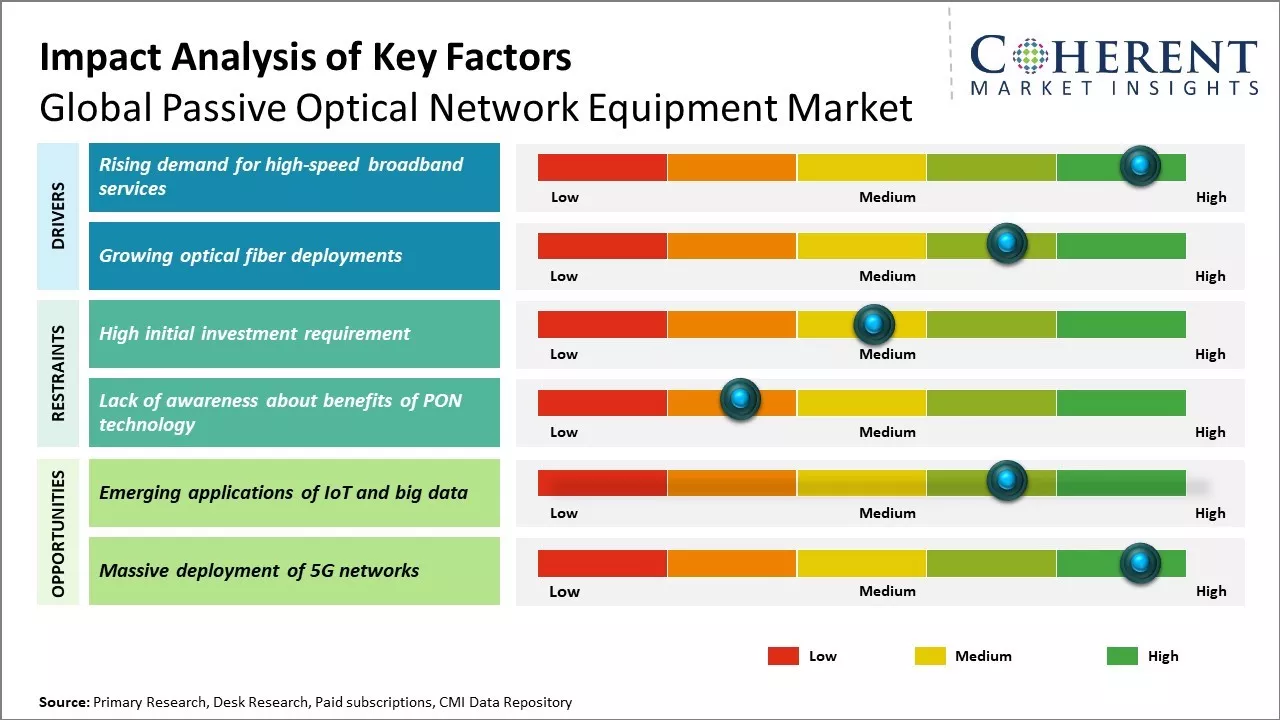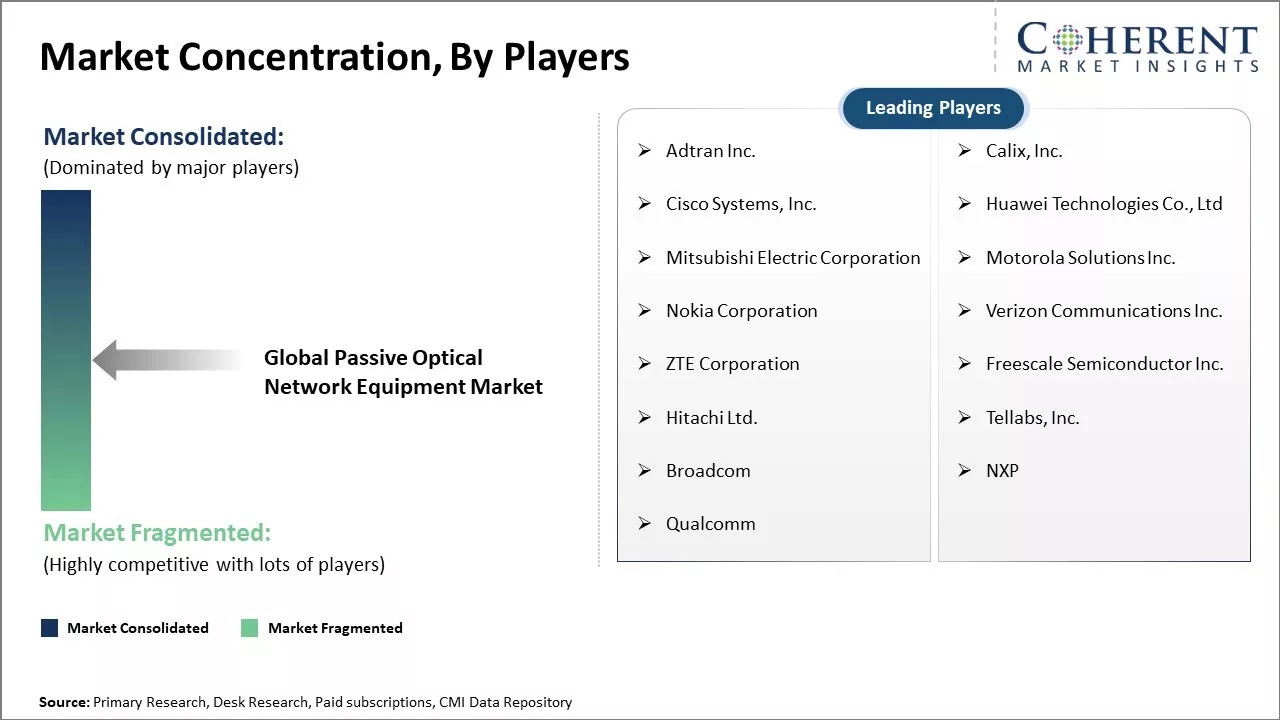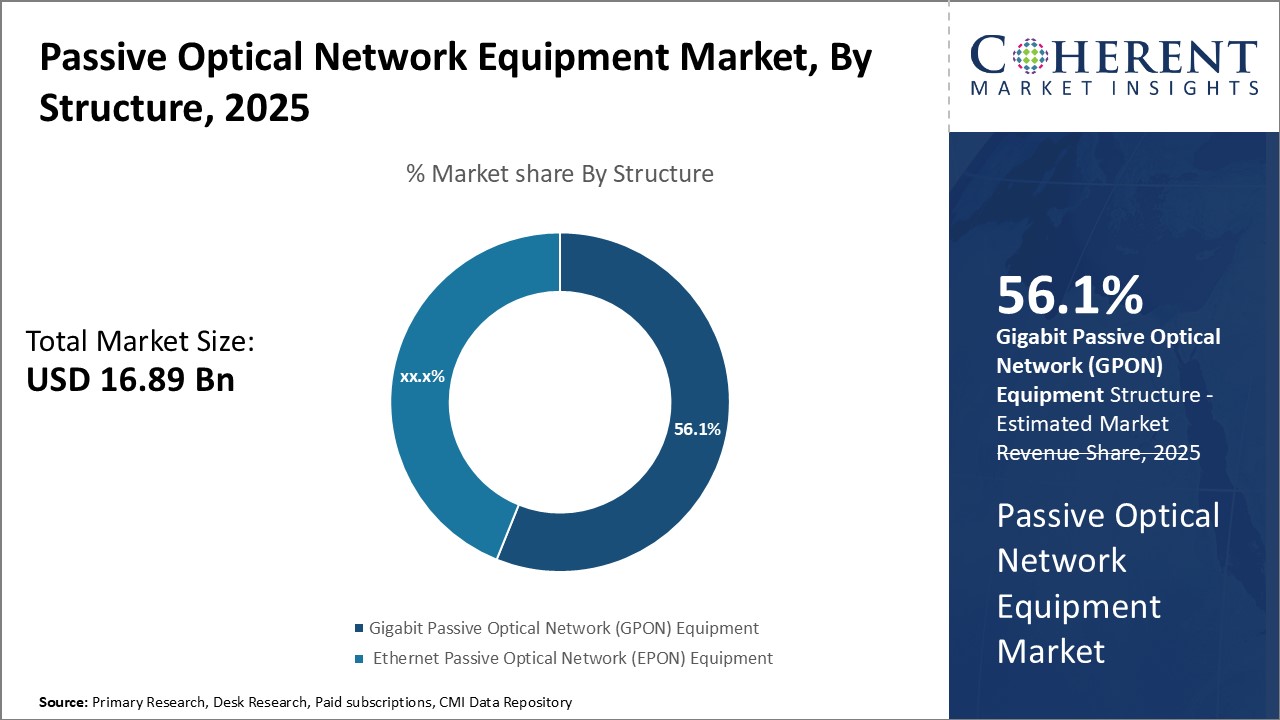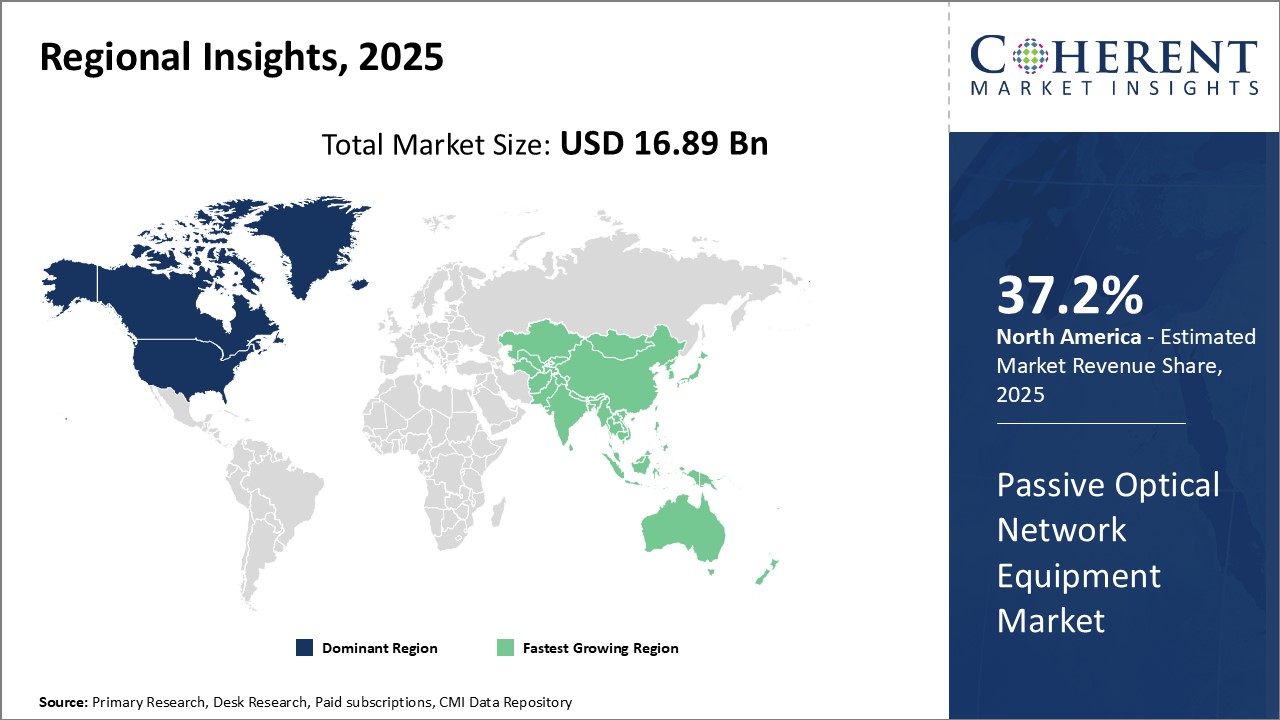The global passive optical network equipment market is estimated to be valued at US$ 16.89 Bn in 2025 and is expected to reach US$ 43.61 Bn by 2032, exhibiting a compound annual growth rate (CAGR) of 14.5% from 2025 to 2032. Passive optical network equipment helps telecom operators provide fiber to the home or building connectivity with advantages of high bandwidth, low latency, and no need for regular maintenance of active equipment.

Discover market dynamics shaping the industry: Download Free Sample
The market is expected to grow steadily driven by increasing investments by telecom operators in fiber infrastructure to support the increasing demand for high speed broadband. 5G deployments will further augment the demand for fiber connectivity. Deployments are expected to be high in regions with initiatives for digital infrastructure. Adoption across industries for applications like video surveillance and enterprise connectivity will further support the market growth during the forecast period.
Rising demand for high-speed broadband services
The mass digitization of content and the growing popularity of video and cloud-based applications has led to a surge in demand for high-speed broadband services across both residential and business sectors globally. As more people work, communicate, stream media and access various online services from home, there is an increasing need for internet connections that can support these bandwidth-intensive activities. At the same time, enterprises are heavily relying on internet infrastructure to drive their digital transformation strategies and improve connectivity within their offices and campuses. This rising demand for high-speed, low-latency connectivity puts tremendous pressure on existing network infrastructure and makes operators look for scalable, future-proof fiber technologies.
Passive optical networks have emerged as an attractive solution as they can deliver symmetrical gigabit bandwidth through fiber all the way to the user premises in a highly scalable manner. Passive Optical Network equipment allows internet service providers to expand coverage, increase capacities and offer premium broadband and connectivity services to residential as well as business customers. Major telecom companies are making sizeable investments to upgrade their access networks with fiber and Passive Optical Network with a goal to roll out internet speeds well over 1 Gbps. Governments across countries have also initiated several programs to enhance broadband access through fiber in both urban and rural regions. All these factors are fueling strong growth in the adoption of PON solutions worldwide.
For instance, in May 2020, Iskratel, a leading European provider of communications solutions for the digital transformation of telecommunications, transportation, public safety, and energy industries announced the deployment of Gigabit Passive Optical Network equipment as part of the RUNE (Rural Network) project, aiming to develop an ultra-fast fibre-optic broadband network across 210 municipalities. This three-year initiative will provide high-speed internet access to 233,000 people, with speeds reaching up to 10 Gbit/s.

Get actionable strategies to beat competition: Download Free Sample
Growing optical fiber deployments
Another key driver for the increasing demand of PON equipment is the rising optical fiber deployments by telecom operators and internet service providers. With network usages and bandwidth consumption growing exponentially, there is a pressing need to shift to fiber-based infrastructure from legacy copper networks which have limited capacities. Fiber broadband enables symmetrical speeds and lower latency compared to other broadband technologies. It also future-proofs the networks to support new technologies such as 5G, Internet of things, Artificial Intelligence (AI), and emerging applications for many years to come. Realizing the long-term benefits of fiber, many nations have launched countrywide fiberization projects with an objective to make high-speed broadband internet as universal and ubiquitous as electricity.
Telecom carriers are aggressively fiberizing their access networks by replacing old telephone wires and cables with state-of-the-art optical fiber connections. At the same time, new fiber network builds are also underway in underserved and unserved communities.
Key Takeaways from Analyst:
The rising demand for high-speed internet across the world is a major driver as PON technology offers 10Gbps plus speeds to end users in a cost-effective manner. Deployments of FTTH/FTTx networks are increasing globally which will spur the demand for PON equipment. North America currently dominate the market due to the wide availability of high-speed broadband. However, the Asia Pacific region is expected to grow the fastest due to government initiatives and increasing investments in digital infrastructure development projects in countries like China and India.
While demand drivers are strong, supply chain disruptions caused due to ongoing component shortages could hamper short term growth prospects. Additionally, slow fiberization rate in developing nations poses a challenge. However, widening FTTH/FTTx rollouts, rising 5G backhaul needs, and emphasis on smart city initiatives provide significant opportunities. Ongoing migration to next-generation PON technologies like XGS-PON and NG-PON2 will also require equipment upgrades. Various field trials of emerging technologies such as 10G PON will help future proof network infrastructure and drive long term equipment upgrade cycles.
Market Challenges: High initial investment requirement
Establishing a passive optical network involves deploying optical fiber cables directly from the operator's central office all the way to the end-user premises. This fiber-to-the-home/building infrastructure build out requires massive capital expenditure. Laying underground or aerial fiber optic cables across cities and towns to reach individual homes and offices is an expensive undertaking that requires careful planning and coordination with local authorities. This upfront build cost poses a significant barrier for internet service providers, especially in underdeveloped regions with low average revenue per user.
The situation is made more challenging given the rapid pace of technological changes in this industry. Once the passive optical infrastructure is deployed, any upgrades needed to support new standards like 5G or higher bandwidth applications may require additional spending on hardware changes. These risks making initial investments obsolete in a relatively short time period. The lumpy capital expenditure pattern means network operators have to make large outlays initially which gets recovered slowly over the contract duration through user subscription revenues. This long return on investment period discourages new entrants and limits the pace at which existing networks can be expanded to reach wider geographic areas and more consumers.
Market Opportunities: Emerging applications of IoT and big data
The increasing adoption of technologies like Internet of Things (IoT) and big data analytics provide a massive opportunity for growth in the global passive optical network equipment market. As more "smart" devices and sensors get connected to process and exchange data over internet, the need for high-speed connectivity with large bandwidth will rise exponentially. Passive optical networks can support this connectivity demand through their fiber to the premises architecture that offers higher speeds and better scalability compared to traditional networks. As data volumes grow exponentially, big data analytics can help organizations draw meaningful insights from IoT data to optimize operations and services. However, analyzing this data often requires moving it to centralized facilities for processing which needs high speed network connectivity. Again, passive optical networks are well suited for this task through their capabilities to deliver ultra-high bandwidth to both residential and business customers along with low latency characteristics. This makes PONs an attractive infrastructure choice for businesses in sectors like manufacturing, utilities, and healthcare among others looking to leverage predictive analytics on their IoT data. Government organizations are also implementing big data driven approaches for public services that rely on high bandwidth connectivity for IoT data networks.

Discover high revenue pocket segments and roadmap to it: Download Free Sample
Insights By Structure: Dominance of GPON Equipment
In terms of structure, Gigabit Passive Optical Network (GPON) equipment contributes the 56.1% share in 2025 for the market owing to its enhanced capabilities compared to EPON equipment. GPON offers higher bandwidth that supports more users and advanced services like ultra-high definition video streaming. It provides downlink speeds of 2.5 Gbps and uplink speeds of 1.25 Gbps through wavelength-division multiplexing. This high-speed connectivity opens up opportunities for internet service providers to offer premium broadband and bundle lucrative value-added services.
Moreover, GPON systems have extended reach of up to 20 km from the central office compared to EPON's limit of 10-20 km, allowing fewer fiber splits and reducing network installation costs for operators. Their broader coverage helps expand internet penetration into rural areas in a cost-effective manner. GPON also ensures better quality of service through individual communication channels for each user and efficient bandwidth allocation. Its sophisticated network management functionalities allow proactive monitoring and optimization of the passive infrastructure. These advantages have made GPON equipment the technology of choice for operators to deliver premium connectivity and future-proof their networks.
Insights By Component: Dominance of Optical Line Terminal Segment
Within the component segment, Optical Line Terminal (OLT) contributes the 62.6% share in 2025 owing to its critical role as the core network element. As the active source endpoint installed at the operator's central offices or fiber nodes, OLT is responsible for transmission and reception of optical signals over the feeder fiber. It splits the optical signal from the single feeder fiber into multiple output fibers going to the different locations through the use of a passive optical splitter.
OLT also performs bandwidth allocation, encryption, monitoring, and management of the entire access network. Due to its high-bandwidth interfaces connected to core networks, robust processing capabilities and reliability requirements, OLT equipment tends to be more advanced in design with sophisticated hardware and software. Moreover, frequent technology upgrades in PON standards necessitate replacement and augmentation of OLT equipment more often compared to ONT. This planned obsolescence of OLT drives continual demand from network operators. Substantial capital is also invested by service providers in OLT deployments as they act as the primary nodal assets for delivering connectivity up to thousands of customers. These factors contribute to the leading market share of OLT segment among PON components.

Need a Different Region or Segment? Download Free Sample
The North America region has dominated the global market for passive optical network equipment with 37.2% share in 2025. Several factors have contributed to the surge in PON adoption and investments in the region. Telecom operators in countries like the U.S. and Canada have accelerated their Fiber to the Premises deployment plans to offer multi-gigabit broadband services to consumers and businesses. This has generated significant demand for XGS-PON and NG-PON2 equipment upgrades. Moreover, large infrastructure projects such as broadband initiatives in rural parts of the U.S. have opened new opportunities. PON equipment manufacturers have responded by setting up local manufacturing and assembly units to cater to the growing regional requirements. As a result, North America is rapidly closing the gap with Asia Pacific, driven by its transition to high-capacity PON infrastructure.
Asia Pacific has emerged as the fastest growing regional market for passive optical network equipment in recent years. This region is home to leading manufacturers of PON equipment, primarily from China, Taiwan, and India. Low cost of production and attractive government policies promoting digital infrastructure build-out have made Asia Pacific an attractive location for PON equipment manufacturing. Leading global brands have established their largest production bases in countries like China to take advantage of low costs. In addition, the massive fiber deployment by telecom operators across Asian countries to support rising internet access demand has fueled high shipments of PON equipment to the region. This robust domestic demand combined with the exports of low cost PON solutions have ensured Asia Pacific’s dominance in the global market.
Passive Optical Network Equipment Market Report Coverage
| Report Coverage | Details | ||
|---|---|---|---|
| Base Year: | 2024 | Market Size in 2025: | USD 16.89 Bn |
| Historical Data for: | 2020 To 2024 | Forecast Period: | 2025 To 2032 |
| Forecast Period 2025 to 2032 CAGR: | 14.5% | 2032 Value Projection: | USD 43.61 Bn |
| Geographies covered: |
|
||
| Segments covered: |
|
||
| Companies covered: |
Adtran Inc., Calix, Inc., Cisco Systems, Inc., Huawei Technologies Co., Ltd, Mitsubishi Electric Corporation, Motorola Solutions Inc., Nokia Corporation, Verizon Communications Inc., ZTE Corporation, Freescale Semiconductor Inc., Hitachi Ltd., Tellabs, Inc., Broadcom, NXP, and Qualcomm |
||
| Growth Drivers: |
|
||
| Restraints & Challenges: |
|
||
Uncover macros and micros vetted on 75+ parameters: Get instant access to report
*Definition: The global passive optical network equipment market consists of optical networking hardware and components that allow telecommunications carriers to provide fiber broadband connectivity using a passive optical network or PON architecture. The equipment includes optical line terminals located at the service provider's central offices, optical network terminals installed at subscriber homes or offices, as well as splitters, couplers, connectors and cables that allow the deployment of fiber internet services via a shared fiber infrastructure without the need for active electronic equipment between providers and subscribers.
Share
Share
About Author
Monica Shevgan has 9+ years of experience in market research and business consulting driving client-centric product delivery of the Information and Communication Technology (ICT) team, enhancing client experiences, and shaping business strategy for optimal outcomes. Passionate about client success.
Missing comfort of reading report in your local language? Find your preferred language :
Transform your Strategy with Exclusive Trending Reports :
Frequently Asked Questions
Joining thousands of companies around the world committed to making the Excellent Business Solutions.
View All Our Clients